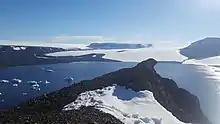Vega Island
Vega Island is a small island to the northwest of James Ross Island, on the Antarctic Peninsula. It is separated from James Ross Island by Herbert Sound. The island was named by Otto Nordenskjold, leader of the Swedish Antarctic Expedition (1901-04) in honour of the ship making the first voyage through the Northeast Passage, 1878-79.
 Map of Graham Land, showing Vega Island (7) | |
 Vega Island Location in Antarctica | |
| Geography | |
|---|---|
| Location | Antarctica |
| Coordinates | 63°50′S 57°25′W |
| Archipelago | James Ross Island group |
| Width | 3 km (1.9 mi) |
| Administration | |
| Administered under the Antarctic Treaty System | |
| Demographics | |
| Population | Uninhabited |

Vega Island is an important site for paleontology. The region is extremely rich in terrestrial and marine fossils which span the boundary of the Cretaceous and Tertiary periods, covering the point in time when dinosaurs became extinct. Fossils found on the island include hadrosaurs, plesiosaurs, and mosasaurs.
Geography
The island is a rare volcano type called a Moberg, or tuya, which was formed by a three-stage eruption sequence below an ice cap. Stage one was a subglacial hyaloclastite eruption, which shattered the lava into glass, ash, and sand which has since weathered to yellow palagonite layers. The second phase was a lava eruption into a meltwater glacial lake contained in the ice cap, which resulted in volcanic breccia and basalt pillow lava. The final phase was subaerial basalt lava flows on top of the previous volcanic deposits after the lake drained or boiled away. The basalt flows forma caprock along the northwest shore, which forms an impermeable layer that results in about sixty waterfalls on warm days.
See also
- Composite Antarctic Gazetteer
- List of Antarctic islands south of 60° S
- SCAR
- Territorial claims in Antarctica
References
- "Vega Island". Composite Gazetteer of Antarctica. Scientific Committee on Antarctic Research (SCAR).
- "New Dinosaur Finds in Antarctica Paint Fuller Picture of Past Ecosystem". National Science Foundation. February 6, 1998.
External links
- Antarctic Researchers to Discuss Difficult Recovery of Unique Juvenile Plesiosaur Fossil, from the National Science Foundation, December 6, 2006.
- Rocas hipabisales del grupo volcánico James Ross, Isla Vega (Spanish)